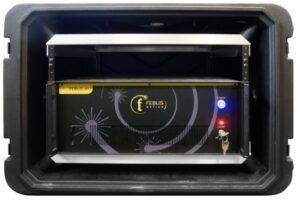Other than delivering films, emails, and tweets, fiber-optic cables that run through the earth, along the seafloor, and into the houses have many other potential uses. Anywhere the cable touches the ground, these signals can also record ground vibrations as small as a nanometer.
 The “interrogator” device is a portable box, about the size of a toaster, that turns optical signals into very precise ground motions. The UW Photonic Sensing Facility has three interrogators that can be used in labs or in the field. Each one collects as much data as 15,000 seismometers. Image Credit: Febus
The “interrogator” device is a portable box, about the size of a toaster, that turns optical signals into very precise ground motions. The UW Photonic Sensing Facility has three interrogators that can be used in labs or in the field. Each one collects as much data as 15,000 seismometers. Image Credit: Febus
Fiber-optic cables have long been used in unexpected ways, but only a small number of military and commercial applications have taken advantage of this.
In a pilot study at the University of Washington, fiber-optic sensing is being investigated for seismology, glaciology, and even urban monitoring.
The new UW Photonic Sensing Facility, which was partially funded by a $473,000 grant from the M.J. Murdock Charitable Trust, a nonprofit organization with headquarters in Vancouver, Washington, has three decoder devices, or “interrogators,” that use photons traveling through a fiber-optic cable to identify ground motions as small as one nanometer.
Fiber-optic sensing is the biggest advance in ground-based geophysics since the field went digital in the 1970s. The UW Photonic Sensing Facility and its partners will explore this technology’s potential across scientific fields—including seismology, glaciology, oceanography, and monitoring hydrology and infrastructure.
Brad Lipovsky, Study Principal Investigator and Assistant Professor, Earth and Space Sciences, University of Washington
The new facility is one of a few research centers across the world that are starting to look at fiber optics for sensing ground motion. It is the largest in the United States and the first of its type in the Pacific Northwest. The quantity of seismic data could increase thousands of times as a result of this monitoring strategy.
For the time being, one of the three UW interrogator devices is connected to a “dark fiber,” or unused cable, that connects the Seattle and Bothell campuses of the university.
To detect volcanic, oceanic, glacial, and tectonic systems in Alaska, the researchers will soon connect to a similar underwater wire that spans Cook Inlet. The other device will be deployed temporarily.
Seismic waves travel out from the source of the vibration, whether it be from an earthquake, a large truck, or building activities. A very tiny strain in the fiber-optic cable caused by a seismic wave disturbs photons that are normally reflected back to the source.
The location of the cable’s disturbance can be identified by the researchers by detecting this interruption in the light waves that are returning.
Since the system is dispersed and can track both sound waves and ground motion, it is known as “distributed acoustic sensing,” or DAS.
More slow motions can also be captured using the same approach. Glacier expert Lipovsky and UW graduate student John-Morgan Manos brought equipment up to Mount Baker’s Easton Glacier to track the pace of surface melt. To determine how much snow was melting on the glacier, the crew set up a cable and utilized an interrogator.
UW scientists working with the Pacific Northwest Seismic Network are investigating various seismology uses, such as earthquakes, volcanoes, and landslides. UW oceanographers will monitor ocean faults and possibly listen in on whales using fiber-optic cables connected to an underwater observatory.
UW civil engineers will analyze whether this technology has the potential for use as a monitor for traffic collisions or building and bridge infrastructure.
Semi-permanent observatories in Seattle, as well as other underused “dark” fibers, such as a cable that goes to Whidbey Island, will be a part of the facility. The team is also looking into projects farther away at a fjord in Greenland and McMurdo Station in Antarctica. They also intend to construct cables for temporary field deployments at Mount Rainier.
We are getting to the ‘smart Earth’ concept, where we can listen to the Earth. his technology allows seismic sensing to go to places you could not go before—where it was too hard, or too expensive, to deploy sensors. The other aspect that is new is a density of sensors beyond what we had before.
Marine Denolle, Assistant Professor, Earth and Space Sciences, University of Washington
While fiber-optic cables capture measurements at several locations along the cable, modern seismometers only record ground motion at a single location. The test cable includes 15,000 data channels. Denolle will analyze this new pile of seismic data using computation and machine learning.
Denolle added, “In seismology, our data used to be just wiggles. his is the first time we can get 2D images, and even videos, of data streaming in.”
At the back end of 2021, the M.J. Murdock Charitable Trust grant was provided. The funds were utilized by researchers to connect and test the equipment last spring, and a data-visualization facility will shortly be built on campus.
“Thanks to the M.J. Murdock Charitable Trust’s support, the UW is the first university to acquire so much equipment for this technique. This is in the pilot experiment stage, and we are excited to see where it goes,” stated Lipovsky.
The University of Washington and the UW-based Pacific Northwest Seismic Network have also provided funding.
UW's Brad Lipovsky and Marine Denolle explain how fiber-optic cables can sense ground motion
Researchers Brad Lipovsky and Marine Denolle explain how fiber-optic cables can be used to sense ground motion. Video Credit: Kiyomi Taguchi/UW
Source: http://www.washington.edu/